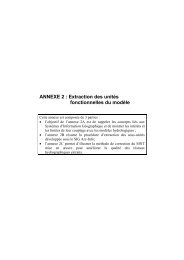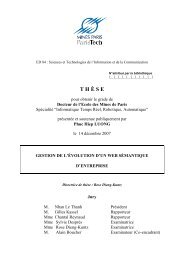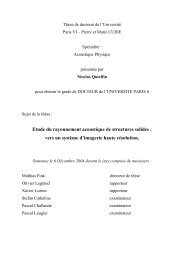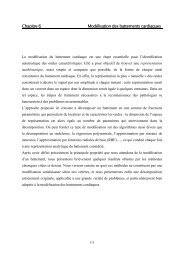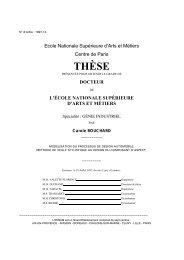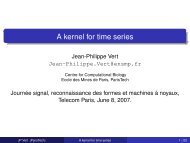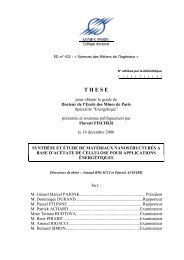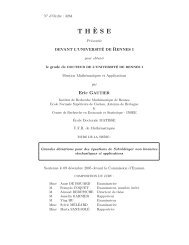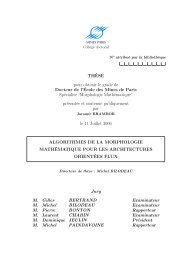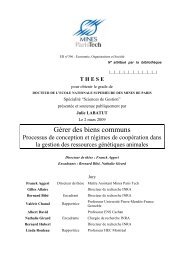Bibliographie - Tel
Bibliographie - Tel
Bibliographie - Tel
You also want an ePaper? Increase the reach of your titles
YUMPU automatically turns print PDFs into web optimized ePapers that Google loves.
<strong>Bibliographie</strong>
<strong>Bibliographie</strong>1. ABBOTT M. B., BATHURST J. C., CUNGE J. A., O'CONNELL P. E. et RASMUSSEN P. E., 1986.An introduction to the European hydrological System. Système Hydrologique Européen, "SHE", 1 :History and philosophy of a physically-based, distributed modelling system. Journal of Hydrology,Vol 87. pp 45-59.2. ADAMS R., 1995. The integration of a physically based hydrological model within a decision supportsystem to model the hydrological impacts of land use change. Scenario studies for the ruralenvironment, J. F. SHOUTE et al, Eds Kluwer, Dordrecht, Pays Bas. pp 209-214.3. ADDISCOTT T. M., HEYS P. J. et WHITMORE A. P., 1986. Application of simple leaching models inheterogeneous soils. Geoderma, Vol , n°38. pp 185-194.4. AFNOR, 1999. Information géographique. Description des données. Métadonnées. XP ENV 12657, août1999/ Z 52-007/ ICS : 35.240.70 Association Française de Normalisation, Paris. 56 p.5. AIF, 1993. Recherche et quantification des paramètres caractéristiques de l'équivalent-habitant : étudebibliographique. Etude Inter Agences, n°23. 41 p.6. ALPASLAN N., HARMANCIOGLU N. B. et SANER E., 1994. Proposed management plan for theYesilirmak river basin, integrated river basin development. Proceedings of an internationalconference, Wallingford, United Kingdom, 13 to 16 sept 1994. pp 97-107.7. AMBROISE B., 1991. Hydrologie des petits bassins versants ruraux en milieu tempéré - Processus etmodèles -. Séminaire du Conseil Scientifique du Département "Science du sol" de l'INRA, Dijon, 26-27/03/1991. pp 34.8. AMBROISE B., 1999a. La dynamique du cycle de l'eau dans un bassin versant : processus, facteurs,modèles. Ecole Polytechnique Fédérale de Lausanne, HGA Bucarest. 200 p.9. AMBROISE B., 1999b. Genèse des débits dans les petits bassins versants ruraux en milieu tempéré : 2 -Modélisation systémique et dynamique. Revue des Sciences de l'Eau, n°12/1. pp 123-153.10. AMBROSE R. B., BARNWELL T. O. et McCUTCHEON S. C., 1996. Computer models for waterquality analysis (Chap. 14). L. W. MAYS (Ed.) Water resources handbook, McGRAW-HILL, NewYork (USA). pp 14.1-14.28.11. ANONYME, 1996. Projet d'étude par télédétection des étangs palavasiens. Sauvegarde des étangs littorauxdu Languedoc-Roussillon. Conservatoire du Littoral. 78 p.12. ANTENUCCI J. C., BROWN K., CROSWELL P. L., KEVANY M. J. et ARCHER H., 1991.Geographic Information Systems : a guide to the technology. Chapman & Hall, New York. 301 p.13. ARHEIMER B. et BRANDT M., 2000. Watershed modelling of nonpoint nitrogen losses from arable landto the Swedish coast in 1985 and 1994. Ecological Engineering, Vol 14, 4. pp 389-404.14. ARHEIMER B. et LIDEN R., 2000. Nitrogen and phosphorus concentrations from agriculturalcatchments-influence of spatial and temporal variables. Journal of Hydrology, Vol 227. pp 140-159.15. ARIKAWA M. et KUBOTA K., 2000. A Standard XML based Protocol for Spatial Data Exchange - itsCapabilities and Real Applications -. International Workshop on Emerging Technologies for Geo-Based Applications, Ascona, Switzerland, May 22-25. Database Laboratory. pp 37-46.16. ARNAUD M. et EMERY X., 2000. Estimation et interpolation spatiale. Hermès Sciences Publications,Paris. 221 p.17. ARNAUD P., 1997. Modèle de prédétermination de crues basé sur la simulation stochastique des pluieshoraires. Extention de sa zone de validité (pourtour méditerranéen français), paramétrisation dumodèle horaire par l'information journalière et couplage des deux pas de temps, Thèse, UniversitéMontpellier II, Montpellier. 286 p.235
<strong>Bibliographie</strong>18. ARNOLD J. G., MUTTIAH R. S., SRINIVASAN R. et ALLEN P. M., 2000. Regional estimation ofbase flow and groundwater recharge in the Upper Mississippi river basin. Journal of Hydrology,Vol 227, 1-4. pp 21-40.19. ARNOLD J. G., SRINIVASAN R., MUTTIAH R. S., ALLEN P. M. et WALKER C., 1999. Continentalscale simulation of the hydrologic balance. J. American Water Ressources Association, Vol 35, n°5.pp 1037-1052.20. ARNOLD J. G. et WILLIAMS J. R., 1995. SWRRB - A watershed scale model for soil and waterresources management. Computer Models of Watershed Hydrology, V. P. SING, Water ResourcesPublications, Littleton, Colorado. pp 847-907.21. ARNOLD J. G., WILLIAMS J. R., NICKS A. D., et SAMMONS N. B., 1990. SWRRB : A basin scalesimulation model for soil and water resources management. Texas A&M University Press, CollegeStation.22. ARNOLD J. G., WILLIAMS J. R., SRINIVASAN R., KING K. W. et GRIGGS R. H., 1994. SWAT(Soil and Water Assessment Tool) User's Manual. USDA, Agricultural Research Service, Grassland,Soil and Water Research Laboratory, Temple, USA.23. ARONICA G., HANKIN B. et BEVEN, K., 1998. Uncertainty and equifinality in calibrating distributedroughness coefficients in a flood propagation model with limited data. Advances in Water Resources,Vol 22, n°4. pp 349-365.24. ASCENCIO E., 1984. Aspect climatologique des départements de la région Languedoc-Roussillon.Monographie Volume 4. Bureau climatique régional du Sud-Est. Ministère des transports direction dela météorologie.25. AYPHASSORHO H., 1992. Modélisation de la qualité des eaux superficielles sur un grand bassin versant :le cas de la rivière Charente. Journées information eaux, Futuroscope de Poitiers, 23-25 septembre1992. CEMAGREF. pp 1-11.26. AYPHASSORHO H., TORRE M., REBILLARD J. P. et LEVIANDIER T., 1993. Modélisation desflux de nitrates au sein d'un bassin versant littoral : le bassin de la Charente. CEMAGREF. 24 p.27. BACHELARD S., 1979. Quelques aspects historiques des notions de modèle et de justification desmodèles. Actes du colloque "Elaboration et justification des Modèles : application en Biologie", TomeI, Paris, Delattre, p. et M. Thellier (ed), Maloine Editeur. pp 3-19.28. BAFFAUT C. et DELLEUR J. W., 1990. Calibration of SWMM Runoff Quality Model with ExpertSystem. Journal of water resources planning and management, Vol 116, n°2. pp 247-261.29. BARKER G. R., 1988. Remote Sensing : The Underlded Component of Geographic Information Systems.Photogrammetric Engineering & Remote Sensing, Vol LIV, 2. pp 195-199.30. BAXTER S. J., OLIVER M. A. et GAUNT, J., 2001. Understanding the spatial variation of mineralnitrogen and potentially available nitrogen at the field scale. Third European Conference on PrecisionAgriculture, Montpellier, 18-20 juin. Ecole Nationale Supérieure Agronomique de Montpellier.pp 1−6.31. BEAR J., 1972. Dynammics of fluids in porous media. Amer, Elsevier, New York.32. BEASLEY D. B. HUGGINS L. F. et MONKE E. J., 1980. ANSWERS : a model for watershed planning.Trans. ASAE, Vol 23, n°4. pp 938-944.33. BEAUJOUAN V., DURAND P. et RUIZ L., 2001. Modelling the effect of the spatial distribution ofagricultural practices on nitrogen fluxes in rural catchments. Ecological Modelling, Vol 137, n°1.pp 93-105.236
<strong>Bibliographie</strong>34. BECK M. B., 1987. Water quality modeling : a review of the analysis of uncertainty. Water ResourcesResearch, Vol 23, n°8. pp 1393-1442.35. BECKER A. et BRAUN P., 1999. Disaggregation, aggregation and spatial scaling in hydrologicalmodelling. Journal of Hydrology, Vol 217. pp 239-252.36. BEDARD Y., 1987. Sur les différents types de systèmes d'information à référence spatiale. Actes duCongrès conjoint de carto-Québec et de l'Association canadienne de cartographie, Québec, pp 73-87.37. BELAMIE R., 1983. Etude des pollutions diffuses en territoire rural : éléments de méthodologie,application à l'étude des bassins versants représentatifs. Colloque sur l'eutrophisation et la pollutiondu Léman, Orgeval, 31 août - 3 septembre. pp 1-48.38. BELAN J., 1979. Influence des pratiques culturales sur le lessivage de l'azote par un modèle pratique.INRA, Station Agronomique du Département de l'Aisne, Laon. 89 p.39. BENDE U., 1997. Regional hydrochemical modelling by delineation of chemical hydrological responseunits (CHRUs) within a GIS: An approach of observing man-made impacts in the Broel Rivercatchment (Germany). Mathematics and Computers in Simulation, Vol 43, 3-6. pp 305-312.40. BENJAMIN J. R. et CORNELL C. A., 1970. Probability, Statistics and Decision for Civil Engineers. McGraw-Hill, New York, USA. 684 p.41. BENNETON J. P., 1984. Eutrophisation des plans d'eau Inventaire des principales sources de substancesnutritives azotées et phosphorées Etude bibliographique. Laboratoire central des ponts et chaussées.68 p.42. BENOIT M., 1992. Un indicateur des risques de pollution nommé BASCULE (Balance Azotée Spécialiséedes Systèmes de CULture de l'Exploitation). Courier de la cellule Environnement INRA, n°18. pp 23-28.43. BENOIT M., 2000. Les recherches sur la protection des bassins d'alimentation produisant des eaux deboisson à la station INRA de Mirecourt. Hydroscopie, n°25. pp 11-12.44. BENOIT M., DEFFONTAINES J. P., GRAS F., BIENAIME E. et RIELA-COSSERAT, R., 1997.Agriculture et qualité de l'eau ; une approche interdisciplinaire de la pollution par les nitrates d'unbassin d'alimentation. Cahiers Agricultures, n°6. pp 97-105.45. BERGMANN A., BREUNIG M., CREMERS A. B. et SHUMILOV S., 2000. Towars an InteroperableOpen GIS. International Workshop on Emerging Technologies for Geo-Based Appllications, Ascona,Switzerland, mai 22-25 2000. Database Laboratory. pp 283-296.46. BERGSTROM S., 1976. Development and application of a conceptual runoff model for Scandinaviancatchments. Swedish Meteorological and Hydrological Institute, RHO Report n°7, Noorkoping.47. BERNARD C., 1865. Introduction à l’étude de la médecine expérimentale. Ed. Flammarion, Paris. 321 p48. BERNIER C. et GALLICHAND J., 1999. Modélisation hydrologique de la qualité de l'eau d'un bassinversant agricole au Quebec. Canadian Agricultural Enginneering, Vol 41, n°4. pp 213-220.49. BERTALANFFY L. V., 1954. General System Theory. Braziller, New York.50. BERTONI J. C., 2001. Etude hydrologique et analyse des incertitudes sur trois bassins versants semiurbanisés de la région centrale d'Argentine, Thèse, Université Montpellier II, Montpellier. 305 p.51. BEVEN K., 1989. Changing ideas in hydrology : the case of physically based models. Journal ofHydrology, Vol 105, n°1/2. pp 157-172.52. BEVEN K., 1993. Prophecy, reality and uncertainty in ditributed hydrological modelling. Advance in waterresources, Vol 16. pp 41-51.237
<strong>Bibliographie</strong>70. BRISSON N., MARY B., RIPOCHE D., JEUFFROY M. H., RUGET F., NICOULLAUD B.,GATE, P., DEVIENNE - BARRET F., ANTONIOLETTI R., DURR C., RICHARD G.,BEAUDOIN N., RECOUS S., TAYOT X., PLENET D., CELLIER P., MACHET J. M.,MEYNARD J. M. et DELECOLLE, R., 1998. STICS : a generic model for the simulation of cropsand their water and nitrogen balances I. Theory and parametrization applied to wheat and corn.Agronomy, n°18. pp 311-346.71. BROWN L. C. et BARNWELL T. O., 1985. Computer Porgram Documentation for the enhanced streamwater quality QUAL2E. EPA/600/3-85/065, U. S. Environmental Protection Agency, Athens,Georgia.72. BRUNSTEIN D., 1996. Utilisation des SIG et modélisations. G.D.R . Analyse et Modélisation desSystèmes Fluviaux Anthropisés : Thème bassins versants urbains, Piren-Seine et CNRS. pp 151-176.73. BURIAN S. J., STREIT G. E., Mc PHERSON T. N., BROWN M. J. et TURIN H. J., 2001. Modelingthe atmospheric deposition and stormwater washoff of nitrogen compounds. Environmental Modellingand Software, Vol 16, 5. pp 467-479.74. BURROUGH P. A. et McDONNEL R. A., 1998. Principles of Geographical Information Systems. OxfordUniversity Press, Oxford. 333 p.75. BURROUGH P. A., 1986. Principles of Geographical Information Systems for Land ResourcesAssessment. Oxford University Press, Oxford. 194 p.76. CA 34, 2000a. Suivi-évaluation des pratiques agricoles en matière de fertilisation azotée (campagne 1997-1998). Chambre d'Agriculture de l'Hérault. 22 p.77. CA 34, 2000b. Suivi-évaluation des pratiques agricoles en matière de fertilisation azotée (campagne 1998-1999). Chambre d'Agriculture de l'Hérault. 22 p.78. CAMPOLONGO F. et SALTELLI A., 1997. Sensitivity analysis of an environmental model : anapplication of different analysis methods. Reliability Engineering and System Safety, Vol 57. pp49−69.79. CAMPOLONGO F., TARANTOLA S. et SALTELLI A., 1999. Tackling quantitatively largedimensionality problems. Computer physics communications, Vol 117, n°1-2. pp 75-85.80. CANN C., 1998. Transferts de polluants vers l'eau. Agriculture intensive et qualité des eaux, INRAEditions. pp 233-247.81. CAZEMIER D., LAGACHERIE P. et MARTIN-CLOUAIRE R., 1998. A Fuzzy Constraint Approachfor Handling Uncertainty in Regional Soil Maps. Data Quality in Geographic Information : FromError to Uncertainty, Editions Hermès, Paris. pp 121-126.82. CEA J., 1971. Optimisation : théorie et algorithmes, Méthode Mathématique de l'Informatique, n°2. 227 p.83. CEMAGREF, 1991. Efficacité de la réduction de la masse des nutriments dans la prévention desmalaïgues : application aux étangs palavasiens. CEMAGREF, USTL, Faculté de Pharmacie,Montpellier. 28 p.84. CEMAGREF et CACG, 1997. Incidences des pratiques agricoles sur la qualité des rivières. Compagnied'aménagement des coteaux de Gascogne / Cemagref / ENGREF / Agence de l'Eau Adour Garonne.261 p.85. CERNESSON F., 1993. Modèle simple de prédétermination des crues de fréquences courantes à rares surdes petits bassins versants méditerranéens, Thèse, Université Montpellier II, Montpellier. 240 p.86. CHARLEUX-DEMARGNE J., 2001. Valorisation des Modèles Numériques de Terrain (MNT) enhydrologie. Qualité d'extraction d'objets et de caractéristiques hydrologiques à partir des MNT.Utilisation pour l'estimation du régime de crue. Thèse, ENSG, Marnes la Vallée. 275 p.239
<strong>Bibliographie</strong>87. CHAUBET I., HAAN C. T., GRUNWALD S. et SALISBURY J. M., 1999. Uncertainty in the modelparameters due to spatial variety of rainfall. Journal of Hydrology, Vol 220, n°1-2. pp 48-61.88. CHOCAT B., 1997. Assainissement autonome des eaux usées. Encyclopédie de l'hydrologie urbaine et del'assainissement, Lavoisier Technique & Documentation, Paris. pp 53-67.89. CHOUDHRY S. et MORAD M., 1998. GIS errors and surface hydrologic modeling : An examination ofeffects and solutions. Journal of Surveying Engineering, Vol 124, n°3. pp p 134-143.90. CHOW V. T., MAIDMENT D. R. et MAYS, L. W., 1988. Applied Hydrology. McGraw-HillInternational Editions, New York. 572 p.91. CHUNG S. W., GASSMAN P. W., KRAMER L. A., WILLIAMS J. R. et GU R., 1999. Validation ofEPIC for two watersheds in southwest Iowa. Journal of Environmental Quality, 28. pp 971-979.92. CLARKE R. T., 1973. Mathematical models in hydrology. Irrigation and drainage paper. Food andAgriculture Organization of the United Nations, Rome.93. CLARKE R. T., 1999. Uncertainty in the estimation of mean annual flood due to rating-curve indefinition.Journal of Hydrology, Vol 222, n°1-4. pp 185-190.94. CLUIS D. et QUENTIN E., 1993. Un système d'information géographique adapté à l'évaluation de lapollution agricole diffuse. HydroGIS'93 : Application of Geographic Information Systems inhydrology and water resources management, Vienne, Autriche, avril 1993. n°211. IAHS Publication.pp 355-361.95. COLAS H., 1991. Modélisation intégrée bassin versant - activités humaines - milieux hydriques :application au bassin versant du Lez et des étangs palavasiens, Thèse, Université des Sciences etTechniques, Montpellier II. 392 p.96. COLOSIMO C. et MENDICINO G., 1996. Scale definition in an integrated GIS hydrological model : acase study. HydroGIS'96 : Application of Geographic Information Systems in hydrology and waterresources management, Vienne, Autriche, avril 1996. n°235. IAHS Publication. pp 385-393.97. CONNOLLY R. D. et SILBURN D. M., 1995. Distributed parameter hydrology model (ANSWERS)applied to a range of catchment scales using rainfall simulator data II : Application to spatiallyuniform catchments. Journal of Hydrology, Vol 172, 1-4. pp 105-125.98. CONNOLLY R. D., CIESIOLKA C. A. A., SIBURN D. M. et CARROLL C., 1997b. Distributedparameter hydrology model (ANSWERS) applied to a range of catchment scales using rainfallsimulator data. IV Evaluating pasture catchment hydrology. Journal of Hydrology, Vol 201, n°1-4.pp 311-328.99. CONNOLLY R. D., SILBURN D. M. et CIESIOLKA C. A. A., 1997a. Distributed parameter hydrologymodel (ANSWERS) applied to a range of catchment scales using rainfall simulator data. III.Application to a spatially complex catchment. Journal of Hydrology, Vol 193, n°1-4. pp 183-203.100. Contrat pour l'étang de Thau, 1997. Suivi des apports du bassin versant de l'étang de Thau et deséchanges avec la mer par les canaux de Sète. Laboratoire Géofluide-Bassin-Eau, Laboratoired'Hydrobiologie marine et continentale, Laboratoire de Biogéochimie et Métrologie Physico-Chimique, Université de Montpellier I et II, Montpellier. 175 p.101. Contrat de Plan Etat Région, 2001. Dynamique et qualité des apports superficiels et souterrains auxlagunes du Languedoc-Roussillon. Laboratoire Hydroscience de l’Université Montpellier II,Département Hydrologie, Géochimie, transferts et l’Unité de Protection de l’Espace du BRGM,Laboratoire de télédétection ENGREF-CEMAGREF, Direction de l’Environnement Littoral de240
<strong>Bibliographie</strong>l’IFREMER et Département Sciences de l’Environnement et Santé Publique de Université deMontpellier I (Faculté de Pharmacie), Montpellier.102. COUILLANDEAU S., 1999. Modèle de transport de l'azote et du phosphore dans le projet de gestionintégrée des bassins versants à l'aide d'un système informatisé (GIBSI). ENGREF, Montpellier. 130 p.103. CRAWFORD N. H. et LINSLEY R. K., 1966. Digital Simulation in Hydrology : Standford WatershedModel IV. Tech. Rep. 39. Dep. Civil Eng., University Standford, Standford. 210 p.104. DAURIAC F., 2000. Analyse de l'utilisation de l'espace pour la quantification des flux d'azote. Applicationau bassin versant de l'étang de l'Or (Hérault). Cemagref/Engref, Montpellier. 100 p.105. DE MARSILY G., 1994. Quelques réflexions sur l'utilisation des modèles en hydrologie. Revue dessciences de l'eau, n°7(1994). pp 219-234.106. DE ROO A. P. J., HAZELHOFF, L., et BURROUGH P. A., 1989. Soil erosion modelling usingANSWERS and geographical information systems. Earth Surface Processes and Landforms, Vol 14.pp 517-532.107. DELATTRE P., 1979. Le problème de la justification des modèles dans le cadre du formalisme dessystèmes de transformations. Actes du colloque "Elaboration et justification des Modèles : applicationen Biologie", Tome I, Paris, Delattre, p. et M. Thellier (ed), Maloine Editeur. pp 97-128.108. DESBORDES M., 1985. Les incertitudes associées à la métrologie en hydrologie urbaine ; leurs incidencessur l'estimation des coefficients de ruissellement. LHM 17/85, Sciences and Technical LanguedocUniversity, Montpellier. 123 p.109. DIOP M., 1980. Contribution à l'étude de systèmes aquifères de plaine littorale (Lez et Vidourle, Hérault,France). Modèle de simulation mathématique. Thèse, Université des Sciences et Techniques duLanguedoc, Montpellier. 138 p.110. DIREN, 1998. Etang de l'Or-Contrat de baie: dossier d'agrément provisoire. 88 p.111. DODGE J. C., 1988. Hydrology past and present. Journal of Hydrological resources, Vol 26. pp 5-25.112. DONIGIAN A. S. et al, 1977. Agricultural runoff management (ARM) model version II : refinement andtesting. U. S. Environmental Protection Agency, EPA-600/3-77-098, Athens, Georgia. 294 p.113. DONIGIAN A. S., et al, 1984. Application Guide for Hydrological Simulation Program-Fortran (HSPF).U.S. Environmental Protection Agency, EPA-600/3-84-065, Athens, Georgia. 177 p.114. DONIGIAN A. S. et CRAWFORD N. H., 1976. Modeling pesticides and nutrients on agricultural lands.U. S. Environmental Protection Agency, EPA-600/2-76-043, Athens, Georgia. 317 p.115. DONIGIAN A. S., IMHOFF J. C. et BICKNELL B. R., 1983. Modeling water quality and the effects ofagricultural best management practices in Four Mile Creek, Iowa. U. S. Environmental ProtectionAgency, Athens, GA. 97 p.116. DONNAY J. P., 1994. Cartographie Topographie. Université de Liège, Liège. 201 p.117. DOOGE J. C. I., 1967. The hydrologic cycle as a closed systems. International Association of ScinetificHydrology Bulletin, Vol 13, n°1. pp 58-68.118. DUPRAZ C., 1984. Bilan des transferts d'eau et d'éléments minéraux dans trois bassins versantscomparatifs à végétations contrastées (Mont Lozère, France), Thèse, Université d'Orléans, Orléans.363 p.119. DUVIGNEAUD P., 1974. La synthèse écologique. Doin, Paris. 296 p.241
<strong>Bibliographie</strong>120. ECKHARDT K. et ARNOLD J. G., 2001. Automatic calibration of a distributed catchment model.Journal of Hydrology, Vol 251, 1-2. pp 103-109.121. EDIJATNO et MICHEL C., 1989. Un modèle pluie-débit journalier à trois paramètres. La HouilleBlanche, n°2. pp 113-121.122. ENGEL B., NAVULUR K. et COOPER B., 1996. Estimating groundwater vulnerability to nonpointsource pollution from nitrates and pesticides on a regional scale. HydroGIS'96 : Application ofGeographic Information Systems in hydrology and water resources management, Vienne, Autriche,avril 1996. n°235. IAHS Publication. pp 521-566.123. EWEN J., 1990. Basis for the subsurface contaminant transport components of the water flow, sedimenttransport, and contaminant transport modelling system SHETRAN-UK. Rep NSS/R229, UK NirexLtd, Harwell, UK.124. EWEN J., 1997. Blueprint for the UP modelling system for large scale hydrology. Hydro. and Earth Sys.Sci., n°1. pp 55-69.125. EWEN J., PARKIN G. et O'CONNELL P. E., 2000. SHETRAN : Distributed River Basin Flow andTransport Modeling System. Journal of Hydrologic Engineering, Vol 5, n°3. pp 250-258.126. FAMIGLIETTI J. S. et WOOD E. F., 1995. Effect of spatial variability and scale on area averagedevapotranspiration. Water Resource Research, Vol 31, n°3. pp 669-721.127. FARAJALLA N. S. et VIEUX B. E., 1995. Capturing the essential spatial variability distributedhydrological modelling : infiltration parameters. Hydrological processes, Vol 9. pp 55-68.128. FEDRA K. et JAMIESON D. G., 1996. The 'WaterWare' decision-support system for river-basin planning.2. Planning capability. Journal of Hydrology, Vol 177, 3-4. pp 177-198.129. FITZHUGH, T. W., et MACKAY, D. S., 2000. Impacts of input parameter spatial aggregation on anagricultural nonpoint source pollution model. Journal of Hydrology, Vol 236, n°1-2. pp 35-53.130. FLETCHER R. et POWELL M. J. D., 1964. A rapidly convergent method for minimization. ComputerJournal, n°6. pp 163-169.131. FLORET MIGUET E., 1995. Quelles stratégies pour limiter les transferts de pollution des rejets urbainspar temps de pluie? Actes des sixièmes journées du Diplôme d'Etudes Approfondies, Paris, 11 et 12mai 1995. Presses de l'Ecole Nationale des Ponts et Chaussées. pp 103-113.132. FLÜGEL W. A., 1996. Application of GIS to derive Hydrological Response Units for hydrologicalmodelling in the Brol catchment, Germany. HydroGIS'96 : Application of Geographic InformationSystems in hydrology and water resources management, Vienne, Autriche, avril 1996. n°235. IAHSPublication. pp 413-420.133. FORTIN J. P., MOUSSA R., BOCQUILLON C. et VILLENEUVE J. P., 1990. Hydrotel, a distributedhydrological model compatible with remote sensing and geographical information systems. Revue desSciences de l'Eau, Vol 8, n°1. pp 97-124.134. FOURCADE B., 2001. Modélisation hydrologique et hydrochimique d'un petit bassin versantméditerranéen, Thèse, Université Montpellier II, Montpellier. 185 p.135. FRERE M. H., ONSTAD C. A. et HOLTAN H. N., 1975. ACTMO, an agricultural chemical transportmodel. U. S. Department of Agriculture, ARS-H-3. 54 p.136. FRERE M. H., ROSS J. D. et LANE L. J., 1980. The nutrient submodel. CREAMS, A field-scale modelfor chemicals, runoff, and erosion from agricultural management systems, Conservation ResearchReport n°26, U. S. Department of Agriculture, Washington DC, USA.242
<strong>Bibliographie</strong>137. FRISSEL M. J. et VAN-VEEN J. A., 1978. Critique of computer simulation modeling for nitrogen inirrigated croplands. Nitrogen in the Environment, Vol 1, Academic Press, New York. pp 145-162.138. GASCUEL ODOUX G., ROBIN P., WALTER C. et MOLENAT J., 1998. Quelles résolutions spatialeset temporelles sont pertinentes pour la modélisation hydrologique des bassins versants d'ordre 1 ?Agriculture intensive et qualité des eaux, INRA Editions. pp 251-265.139. GAUME E., VILLENEUVE J. P., et DESBORDES M., 1998. Uncertainty assessment and analysis of thecalibrated parameter values of an urban storm water quality model. Journal of Hydrology, Vol 210,n°1-4. pp 38-50.140. GE C., 1988. Contribution à la modélisation physico-chimique de l'étang de Thau, Thèse, Université desSciences et Techniques du Languedoc, Montpellier. 168 p.141. GENG Q. Z., 1991. Modélisation du transfert de nitrates dans un système hydrologique. La HouilleBlanche, n°1-1991. pp 23-36.142. GINESTE P., 1998. Contribution de l'imagerie satellitale radar ERS à la détection des zones saturées et à lamodélisation hydrologique d'un petit bassin versant agricole par TOPMODEL, Thèse, ENGREF :spécialité sciences de l'eau, Montpellier. 224 p.143. GIRARD G., MORIN G. et CHARBONNEAU R., 1972. Modèle précipitation-débits à discrétisationspatiale, Cahier ORSTOM, série hydrologique, Vol IX, n°4, pp 5-52.144. GIRARD G., LEDOUX E. et VILLENEUVE J. P., 1981. Le modèle Couplé, simulation des écoulementsde surfaces et souterrains sur un système hydrologique. Cahier O.R.S.T.O.M., Série Hydrologique,Vol XVIII, n°4. pp 195-279.145. GIRARD M. C. et GIRARD C., 1999. Traitement des données de télédétection. DUNOD, Paris. 529 p.146. GOMIS F. et GRESILLON J. M., 2000. Role d'un socle fissuré sur l'hydrologie d'un bassin versant; Roleof a fractured basement on the hydrology of a catchment. Comptes Rendus de l'Academie des Sciences- Series IIA - Earth and Planetary Science, Vol 330, n°5. pp 341-346.147. GOODCHILD M. F., 1978. Statistical aspects of the polygon overlay problem. Harvard papers onGeographic Information Systems, G. Dutton (ed), Addison-Wesley.148. GOODCHILD M. F., 1980. Fractals and the accuracy of geological measures. Mathematical Geology,Vol 12. pp 85-98.149. GOODCHILD, M. F., 1993a. Data models and data quality : problems and prospects. Environmentalmodeling with GIS. pp 94-103.150. GOODCHILD M. F., 1993b. The state of GIS for environmental problem-solving. Environmentalmodeling with GIS. pp 8-15.151. GRAYSON R. B., BLOSCHL G., BARLING R. D. et MOORE I. E., 1993. Process, scale andconstraints to hydrological modelling in GIS. HydroGIS 93 : Application of Geographic InformationSystem in Hydrology and Water Resources, Vienna Conférence, Avril 1993. n°211. IAHS (Publ.)Oxfordshire, Grande Bretagne. pp 83-92.152. GRAYSON R. B., MOORE L. D. et MCMAHON T. A., 1992. Physically based hydrologic modelling 1.a terrain-based model for investigation purposes. Water Resource Research, Vol 26, n°10.pp 2639−2658.153. GRAYSON R. et BLOSCHL G., 2000. Spatial modelling of catchment dynamics. Spatial patterns incatchment hydrology : observations and modelling, Cambridge University Press, UK. pp 51-81.243
<strong>Bibliographie</strong>154. GRENIER P., RACAULT Y. et MEKIKDJIAN C., 1998. Méthode simplifiée d'évaluation de la chargepolluante d'une cave en période de vendange. 2eme congrès international sur le traitement deseffluents viticoles, Bordeaux, 5-7 mai 1998. Cemagref. pp 15-24.155. GRUNWALD S. et NORTON L. D., 2000. Calibration and validation of a non-point source pollutionmodel. Agricultural Water Management, Vol 45, n°1. pp 17-39.156. GUILBOT A. et TOURNOUD M. G., 1991. Equipement en systèmes de mesure et télémesures du bassinde Thau (bassin versant et étang) en vue de la gestion intégrée de l'écosystème lagunaire (rejets etmilieu). Contrat MEDSPA 90-1/F/0011/F/05, Commission des communautés européennes, DG XI-C-2. 32 p.157. GUPTA S. K. et SOLOMON S. I., 1977. Distributed numerical model for estimating runoff and sedimentdisharge of ungaged rivers. 1. The information system. Water resources research, Vol 13, n°3.pp 613-618.158. HAGIN J. et AMBERGER A., 1974. Contribution of fertilizers and manures to the N- and P-load ofwaters, a computer simulation. Final report of the Deutsche Forschungsgemeinschaft, Bonn,Technische Universitat Munchen and Technicon, Haifa. 123 p.159. HANSEN S., JENSEN H. E., NIELSEN N. E. et SVENDSEN H., 1990. DAISY : Soil Plant AtmosphereSystem Model. NPO Report n°A10. The National Agency for Environmental Protection, Copenhage.272 p.160. HELLWEGER F. L. et MAIDMENT D. R., 1999. Definition and connection of hydrologic elementsusing geographic data. Journal of Hydrologic Engineering, Vol 4, n°1. pp 10-18.161. HENAULT C., 1995. Quantification de la dénitrification dans les sols à l'échelle de la parcelle cultivée, àl'aide d'un modèle prévisionnel, Thèse, ENSAM, Montpellier. 132 p.162. HEYMANN 1993. CORINE Land Cover. Guide technique publié par la commission des CommunautésEuropéennes, Luxembourg. 144 p.163. HILL D. R. C., 2000. Contribution à la modélisation de systèmes complexes : application à la simulationd'écosystèmes. Mémoire d'habilitation à diriger des recherches de l'Université Blaise Pascal,Spécialité : Informatique, Clermont-Ferrand. 123 p.164. HOLTAN H. N. et al, 1975. USDHL-74 revised model of watershed hydrology. Department ofAgriculture, Tech. Bull. N°1518.165. HUBBARD, R. K., 1986. Nitrate movement into shallow ground water through a coastal plain sand.Transactions of the ASAE, Vol 29, n°6. pp 1564-1571.166. IMHOFF J. C., BICKNELL B. R. et DONIGIAN A. S., 1983. Preliminary application of HSPF to theIowa River Basin to model water quality and the effects of agricultural best management practices. U.S. Environmental Protection Agency, Athens, GA. 98 p.167. JACOBSEN I., CHRISTERNON M., JONSSON P. et OVERGAARD G., 1992. Objet-OrientedSoftware Engineering : A Use Case Driven Approach. Addison-Wesley, Wokingham. 524 p.168. JAMIESON C. A. et CLAUSEN J. C., 1988. Test of the CREAMS model on agricultural fields Vermont.Water Resources Bulletin, Vol 24, n°6. pp 1219-1226.169. JAMIESON D. G. et FEDRA K., 1996a. The « Waterware » decision-support system for river-basinplanning. 1. Conceptual design. Journal of Hydrology, n°177. pp 163-175.170. JAMIESON D. G. et FEDRA K., 1996b. The « WaterWare » decision-support system for river-basinplanning. 3. Example applications. Journal of Hydrology, Vol 177, 3-4. pp 199-211.244
<strong>Bibliographie</strong>171. JETON A. E. et LARUE-SMITH J., 1993. Development of watershed models for two Sierra Nevadabasins using a geographic information system. Water resources bulletin, Vol 29, n°6. pp 923-932.172. KACAROGLU F., 1999. Review of groundwater pollution and protection in karst areas. Water, Air, andSoil Pollution, Vol 113, n°1-4. pp 337-356.173. KALININ G. P. et MILYUKOV P. I., 1957. O Raschete Neustanovivshegosya Dvizheniya Vody VOtkrytykh Ruslakh [On the Computation of Unsteady Flow in Open Channels]. Meteorologiya iGidrologiya Zhuzurnal, Vol 10. pp 10-18.174. KAUARK LEITE L. A., 1990. Réflexions sur l'utilité des modèles mathématiques dans la gestion de lapollution diffuse d'origine agricole, Thèse, Ecole Nationale des Ponts et Chaussées. 342 p.175. KEMP K. K., 1993. Spatial databases : sources and issues. Environmental modeling with GIS. pp 363-371.176. KING K. W., ARNOLD J. G., et BINGNER R. L., 1999. Comparison of Green-Ampt and curve numbermethods on Goodwin creek watershed using SWAT. Transactions of ther ASEA, Vol 42, n°4. pp 919-925.177. KITE G. W. et KOUWEN N., 1992. Water modeling using land classifications. Water Resource Research,Vol 28, n°12. pp 3193-3200.178. KLEMES V., 1983. Conceptualization and scale in hydrology. Journal of Hydrology, Vol 65, n°1-3.pp 139-158.179. KLEMES V., 1986. Dilettantism in hydrology : transition or destiny ? Water Resource Research, Vol 22,n°9. pp 177-188.180. KNISEL W. G., 1980. CREAMS : a field-scale model for chemicals, runoff, and erosion from agriculturalmanagement systems. Conservation Research Report n°26, U. S. Department of Agriculture,Washington D. C. 643 p.181. KOSITSAKULCHAI E., 2001. Modélisation de la dynamique de l'hydrosytème du bassin du Mae Klong(Thailande), Thèse, Université Montpellier II, Sciences de la Terre et de l'Eau, Montpellier. 280 p.182. KRYSANOVA V., MULLER WOHLFEIL D. I. et BECKER A., 1996. Mesoscale Integrated Modellingof Hydrology and Water Quality with GIS Interface. Third International Conference/Workshop onIntegrating GIS and Environmental Modeling, Santa Fe, Nouveau Mexique, USA, 21-25 janvier.National Center for Geographic Information and Analysis. pp 1-9.183. KRYSONAVA V., MEINER A., ROOSAARE J. et VASILYEV A., 1989. Simulation modelling of thecoastal waters pollution from agricultural watershed. Ecological Modelling, n°49. pp 7-29.184. LANGLOIS A. et PHIPPS M., 1997. Automates cellulaires : application à la simulation urbaine. EditionsHermès, Paris. 197 p.185. LAURENT F., 1996. Outils de modélisation spatiale pour la gestion intégrée des ressources en eau :Application aux Schémas d'Aménagement et de Gestion des Eaux, Thèse, Ecole Nationale Supérieuredes Mines, Paris. 357 p.186. LAURINI R. et MILLERET RAPPORT F., 1993. Les bases de données en géomatique. Hermes. 340 p.187. LAURINI R. et THOMPSON D., 1992. Fundamentals of spatial information systems. The APIC series,Academic Press Inc, London, UK.188. LE MOIGNE J. L., 1977. La théorie du système général. Presses UNiversitaires de France, Paris. 258 p.189. LENZI M. A. et DI LUZIO M., 1997. Surface runoff, soil erosion and water quality modelling in theAlpone watershed using AGNPS integrated with a Geographic Information System. European Journalof Agronomy, Vol 6, 1-2. pp 1-14.245
<strong>Bibliographie</strong>190. LEONARD R. A., KNISEL W. G. et STILL D. A., 1987. GLEAMS : Groundwater Loading Effects ofAgricultural Management Systems. Transactions of the ASAE, Vol 30, n°5. pp 1403-1418.191. LEONE A., PRETI F. et RIPA M. N., 2000. Lake trophic state and agro-forestry land use : the case oflake Vico (centre de l'Italie). First world water Congress of the International Water Association,Paris, 3-7 juillet. Book 5 : Water Resources and Waste Management. pp 32-39.192. LESOUEF A., SIBONY J. et ROGALLA F., 1990. Elimination de l'azote et du phosphore : état de l'art etperspectives d'avenir. La mer et les rejets urbains, Ile de Bendor, 13-15 juin 1990. IFREMER. pp 53-72.193. LETTENMAIER D. P. et WOOD E. F., 1992. Chapter 26 : Hydrologic Forecasting. Handbook ofHydrology, Editor in Chief MAIDMENT, D. R., McGRAW-HILL, INC. pp 26.1-26.30.194. LEVIANDIER T., 1993. Scale considerations in propagation of flows through a network of reservoirs.EGS. pp 22.195. LEVIANDIER T., LOUMAGNE C., NEDELEC Y., BARTOLI F. et GOMENDY V., 1995. Diversitédes approches du changement d'échelle en hydrologie. Séminaire inter-chercheurs. Les modèles auCemagref : formulation validation pertinence, Gif-sur-Yvette, 12-13 octobre 1995. pp 111-118.196. LIDEN R., VASILYEV A., STALNACKE P., LOIGU E. et WITTGREN H. B. U., 1999. Nitrogensource apportionment--a comparison between a dynamic and a statistical model. EcologicalModelling, Vol 114, 2-3. pp 235-250.197. LLAMAS J., 1993. Hydrologie générale : Principes et Applications. Gaetan morin éditeur. 527 p.198. LUNN R. J., ADAMS R., MACKAY R. et DUNN S. M., 1996. Development and application of anitrogen modelling system for large catchments. Journal of Hydrology, Vol 174, 3-4. pp 285-304.199. MA Z. C., 1991. Modélisation du transfert des nitrates : du bassin de recherche au grand bassin, Thèse,Université Louis Pasteur, Strasbourg. 183 p.200. MA Z. C., LEVIANDIER T. et FERRY M., 1990. Fitting a conceptual hydrologic model accounting fornitrate loss in an agricultural representative basin. Proceedings of the Conference on Hydrologicalresearch basins and the environment, Wagenigen, pp 319-327.201. MAGILLO P. et DE FLORIANI L., 2000. A library for multiresolution modeling of field data in GIS.International Workshop on Emerging Technologies for Geo-Based Applications, Ascona, Switzerland,May 22-25. Database Laboratory. pp 133-152.202. MAIDMENT D. R., 1993a. GIS and hydrologic modeling. Environmental modeling with GIS, OxfordUniversity Press, Oxford. pp 147-167.203. MAIDMENT D. R., 1993b. Developping a spatially distributed unit hydrograph by using GIS.HydroGIS'93 : Application of Geographic Information Systems in hydrology and water resourcesmanagement, Vienne, Autriche, avril 1993. n°211. IAHS Publication. pp 181-192.204. MAILHOT A., ROUSSEAU A. N., MASSICOTTE S., DUPONT J. et VILLENEUVE J. P., 1997. Awatershed-based system for the integrated management of surface water quality : The GIBSI system.Water Science & Technology, Vol 36, n°5. pp 381-387.205. MAILLET L., 1995. Directive Nitrate : éléments du diagnostic de la zone vulnérable de l'étang de l'Or.Ecole Nationale Supérieure Agronomique, Montpellier. 42 p.206. MAISON P., 2000. Un modèle hydrologique de suivi de la pollution diffuse en bassin versant : Approchemécaniste simplifiée de la zone non saturée, Thèse, Institut National Polytechnique de Toulouse.303 p.246
<strong>Bibliographie</strong>207. MAKHLOUF Z., 1994. Compléments sur le modèle pluie-débit GR4J et essai d'estimation de sesparamètres, Thèse, Université Paris XI, Paris. 227 p.208. MANGUERRA H. B. et ENGEL B. A., 1998. Hydrologic parameterization of watersheds for runoffprediction using SWAT. Journal of the American Water Resources Association, Vol 34, n°5. pp 1149-1162.209. MANTILLA MORALES G., 1995. Modélisation des transferts de nitrates, confrontation des concepts, desdonnées et des informations : application au bassin de la Charente, Thèse, Doctorat Sciences ettechniques de l'environnement, Ecole Nationale des Ponts et Chaussées de Paris, Paris. 179 p.210. MARANDA Y. et SASSEVILLE J. L., 1999. Efficacité de l'assainissement des eaux usées sur le bassin dela rivière Chaudière. Revue des Sciences de l'Eau, Vol 12, n°3. pp 485-507.211. MAUREL P., 1991. Agricultural land use mapping in Mediterranean area. IGARSS'91 Remote Sensing :global monitoring for earth management, II. pp 355-358.212. McCARTY G. T., 1939. The unit hydrograph and flood routing. U.S. Corps Eng. Off., Providence, R. I.213. MEIN R. G., et BROWN B. M., 1978. Sensitivity of optimized parameters in watershed models. WaterResources Research, Vol 14, n°2. pp 299-303.214. METCALF E. et University of Florida and Water Resources Engineers, 1971. Storm water managementmodel, volume I - final report. Water Pollution Control Research Series 11024 DOC 07/71,Environmental Protection Agency, Washington D.C.215. MEYBECK M., 1985. Variabilité dans le temps de la composition des rivières et de leurs transports ensolution et en suspension. Revue Française des sciences de l'Eau, n°4. pp 93-121.216. MEYBECK M., BOULOUBASSI I., HUANG WEI WEN, HUBERT P., PASCO A., RAGU A. etTOMA A., 1992. Etablissement des flux polluants. Rapport interagences, Laboratoire de Géologieappliquée, Naturalia Biologia. 500 p.217. MICHEL C., 1983. Que peut-on faire en hydrologie avec un modèle conceptuel à un seul paramètre ? LaHouille Blanche, 1. pp 39-44.218. MILLER J. A., 1965. Living systems. Behavioral science, Vol 10, n°3-4. pp 103-411.219. MOLENAAR M., 1998. The fuzzy Spatial Extent of Objets Identified with Remote Sensing and Photo-Interpretation. Data Quality in Geographic Information : From Error to Uncertainty, Editions Hermès,Paris. pp 127-134.220. MOLNAR D. K. et JULIEN P. Y., 2000. Grid-size effects on surface runoff modeling. Journal ofHydrologic Engineering, Vol 5, n°1. pp 8-16.221. MOORE I. D., TURNER A. K., WILSON J. P., JENSON S. K. et BAND L. E., 1993. GIS and landsurface-subsurfaceprocess modelling. Environmental modelling with GIS, Oxford University Press,Oxford. pp 197-230.222. MORRIS K., HILL D. et MOORE A., 2000. Mapping the environment through three-dimensional spaceand time. Computers, Environment and Urban Systems, Vol 24, n°5. pp 435-450.223. MOSTAGHIMI S., PARK S. W., COOKE R. A., et WANG S. Y., 1997. Assessment of managementalternatives on a small agricultural watershed. Water Research, Vol 31, 8. pp 1867-1878.224. NAPOLITANO P. et FABBRI G., 1996. Single-parameter sensitivity analysis for aquifer vulnerabilityassessment using DRASTIC and SINTACS. HydroGIS'96 : Application of Geographic InformationSystems in hydrology and water resources management, Vienne, Autriche, avril 1996. n°235. IAHSPublication. pp 559-566.247
<strong>Bibliographie</strong>225. NASCIMENTO N. O., 1995. Appréciation à l'aide d'un modèle empirique des effets d'action anthropiquessur la relation pluie-débit à l'échelle du bassin versant, Thèse, CERGRENE/ENPC, Paris. 550 p.226. NASH J. E., et SUTCLIFFE J. V., 1970. River flow forecasting through conceptual models, part I : adiscussion of principles. Journal of Hydrology, Vol 10, n°3. pp 282-290.227. NDIRITU J. G. et DANIELL T. M., 2001. An improved genetic algorithm for rainfall-runoff modelcalibration and function optimization. Mathematical and Computer Modelling, Vol 33, n°6-7. pp 695-706.228. NELDER J. A. et MEAD R., 1964. A simple method for function minimization. Computer journal, Vol 7.pp 308-313.229. NINHAM S., 1993. Water quality assessement of the Kuils river. Report of the western Cape RegionalServices Council, Cape Town.230. OTV, 1994. Dépolluer les eaux pluviales: contribution à l'élaboration d'une stratégie. Lavoisier TEC &DOC. 349 p.231. PANICONI C., KLEINFELDT S., DECKMYN J. et GIACOMELLI A., 1999. Integrating GIS and datavisualization tools for distributed hydrologic modeling. Transactions in GIS, Vol 3, n°2. pp 97-118.232. PANTEL J., 2000. Etude et modélisation des couplages entre l'hydrodynamique et les mécanismes detransfert de pollutions azotées en milieu alluvial fortement hétérogène. Nappe de Vistrenque (Gard),Thèse, Université Montpellier II, Montpellier. 165 p.233. PARENT C., 2000. A CASE tool for designing Spatio-Temporal Databases. International Workshop onEmerging Technologies for Geo-Based Applications, Ascona, Switzerland, May 22-25. DatabaseLaboratory. pp 1-19.234. PARKIN G. et O'CONNELL P. E., 1999. Integration of the SHETRAN catchment modelling systemwithin a DSS framework. 2d Inter-Regional Conference on Environment-Water, Lausanne,Switzerland, September 1-3 1999. pp 1-9.235. PARKIN G., O'DONNELL G., EWEN J., BATHURST J. C., O'CONNELL P. E. et LAVABRE J.,1996. Validation of catchment models for predicting land-use and climate change impacts. 2. Casestudy for a Mediterranean catchment. Journal of Hydrology, Vol 175, 1-4. pp 595-613.236. PEKAROVA P., KONICEK A. et MIKLANEK P., 1999. Testing of AGNPS Model Application inSlovak Microbasins. Physics and Chemistry of the Earth, Part B: Hydrology, Oceans andAtmosphere, Vol 24, 4. pp 303-305.237. PERRIN C., 2000. Vers une amélioration d'un modèle global pluie-débit au travers d'une approchecomparative, Thèse, INP Grenoble, Antony. 530 p.238. PICOT B. et CABANIS J. C., 1998. Caractérisation des effluents viticoles : évolution des chargespolluantes de deux caves viticoles du sud de la France sur deux cycles annuels. 2eme congrèsinternational sur le traitement des effluents viticoles, Bordeaux, 5-7 mai 1998. Cemagref. pp 321-326.239. PINHEIRO A., 1995. Un outil d'aide à la gestion de la pollution agricole : le modèle POLA, Thèse, InstitutNational Polytechnique, Toulouse. 289 p.240. PLAGNES V. et BAKALOWICZ M., 2001. The protection of karst water resources: The example of theLarzac karst plateau (south of France). Environmental Geology, Vol 40, n°3. pp 349-358.241. POPPER K., 1973. La logique de la découverte scientifique. Payot.242. PRADO R. B. et DANIEL L. A., 2000. Application of QUAL2E model and GIS to verify the contributionby nonpoint pollution sources in the degradation of the middle Pardo river - SP - Brazil. 4thInternational Conference on Integrating GIS and Environmental Modeling (GIS/EM4) : Problems,248
<strong>Bibliographie</strong>Prospects and Research Needs., Banff, Alberta, Canada, September 2 - 8, 2000. disponible surhttp://www.Colorado.EDU /research/cires/banff/upload/376/.243. PRAT M., 1982. Simulation numérique de transport de produits réactifs dans les sols, cas de l'azote dans lesrelations bassin-versant rivière. Thèse de Docteur-Ingénieur de l'Institut National Polytechnique deToulouse. 184 p.244. PRELAZ DROUX R., 1995. Système d'information et gestion du territoire : approche systématique etprocédure de réalisation. Presses polytechniques et universitaires romandes, Lausanne. 156 p.245. PUECH C., 1996. Du m² au bassin versant : la difficulté du passage d'échelle. 10 èmes journéeshydrologiques "interactions surface continentale atmosphère" ORSTOM, Montpellier, 13-14septembre 1994. pp 487-505.246. PUECH C., 2000. Utilisation de la télédection et des modèles numériques de terrain pour le connaissancedu fonctionnement des hydrosystèmes, Habilitation à diriger des recherches, Mécanique des milieux,Géophysique et Environnement, INPG Grenoble. 83 p.247. PUECH C., VINE P. et WEESAKUL U., 1995. Hydrologie et télédétection : utilisation d'un découpagegéographique selon la végétation pour expliquer les écoulements annuels de petits bassins versantsméditerranéens. 5èmes journées scientifiques du Réseau Télédétection de l'AUPELF-UREFTélédétection des ressources en eau, Tunis, 21-24 septembre 1993. pp 53-62.248. PURICELLI A., UBEDA T., LAURINI R. et SERVIGNE S., 1997. Spatial Database InconsistencyChecking and correcting. Data quality in Geographic Information, Editions Hermès, Paris. pp 111-119.249. QUARTERONI A., SACCO R. et SALERI F., 2000. Méthodes numériques pour le calcul scientifique.Springer-Verlag, France. 444 p.250. RAHMAN M. et SALBE I., 1995. Modelling impacts of diffuse and point source nutrients on the waterquality of South Creek catchment. Environment International, Vol 21, 5. pp 597-603.251. RAO M. N., WAITS D. A. et NEILSEN M. L., 2000. A GIS-based modeling approach for implementationof sustainable farm management practices. Environmental Modelling and Software, Vol 15, 8. pp 745-753.252. RAST W. et LEE G. F., 1983. Nutrient loading estimates for lakes. Journal of Environmental Engineering,n°109. pp 502-517.253. REICHERT P., BORCHARDT D., HENZE M., RAUCH W., SHANANAN P., SOMLYODY L. etVANROLLEGHEM P., 2001. River Water Quality Model no. 1 (RWQM1): II. Biochemical processequations. Water Science and Technology, Vol 43, n°5. pp 11-30.254. REJESKI D., 1993. GIS and risk : a three culture problem. Environmental modeling with GIS. pp 318-362.255. RISSONS M., 1995. Incidence de la complexité du milieu physique et des lois de comportement sur laréponse hydrologique d'un bassin versant. Modèle de représentation et de dynamique. Application aubassin de la Peyne, Thèse, Université des Sciences et Techniques, Montpellier II. 364 p.256. ROCHE M., 1963. Hydrologie de surface. Office de Recherche Scientifique et Technique d'Outre-Mer,Paris, Gautier-Villars. 430 p.257. ROCHE P. A., 1988. Les modèles. Gestion des eaux : Automatisation, Informatisation et Télégestion,Tome III, F. Valiron (Ed). pp 138-166.258. RODE M. et FREDE H. G., 1999. Testing AGNPS for Soil Erosion and Water Quality Modelling inAgricultural Catchments in Hesse (Germany). Physics and Chemistry of the Earth, Part B: Hydrology,Oceans and Atmosphere, Vol 24, 4. pp 297-301.249
<strong>Bibliographie</strong>259. ROSENBROCK H. H., 1960. An automatic method for finding the greatest or least value of a function.Computer journal, Vol 3. pp 175.260. ROSS B. B., CONTRACTOR D. et SHANHOLTZ V. O., 1979. A finite element model of overland andchannel flow for assessing the hydrologic impact of landuse change. Journal of Hydrology, Vol 41.pp 1-30.261. ROUZET C., 1992. Répertoire des études pédologiques réalisées dans le Languedoc-Roussillon. InventaireGestion Conservation des Sols, INRA Science du Sol, ENSAM, Montpellier. 86 p.262. RYDING S. O. et RAST W., 1992. Le contrôle de l'eutrophisation des lacs et des réservoirs. Sciences del'environnement 9. MASSON. 294 p.263. SAGOT O., 1999. Conception et réalisation d'une couche d'informations géoréférencées sur l'occupation dusol des zones humides et de leurs bassins versants du littoral de la région Languedoc-Roussillon.Université Louis Pasteur, Strasbourg. 62 p.264. SALTELLI A. 2000. What is sensitivity analysis ? Mathematical and statistical methods for sensitivityanalysis, SALTELLI A., CHAN K. and SCOTT M., Probability and Statistics Series, J Wiley & Sons.pp 1-22.265. SAULNIER G. M., 1996. Information pédologique spatialisée et traitements topographiques améliorésdans la modélisation hydrologique par TOPMODEL, thèse, Mécanique des milieux, Géophysiques etEnvironnement, INPG, Grenoble. 275 p.266. SCHLULTZE R. E., 1989. ACRU Background, Concepts and Theory. Report of Water ResourceCommission n°154/1/89, Departement of Agricultural Engineering, University of Natal.267. SEBILLOTTE M. et MEYNARD J. M., 1990. Systèmes de culture, système d'élevage et pollutionsazotées. Nitrates-Agriculture-Eau, Paris-La Défense, 7-8 novembre 1990. INRA Publication.pp 289−312.268. SHANNON C. E. et WEAVER W., 1949. The Mathematical Theory of Communication. University ofIllinois Press, Urbana.269. SHESKIN D. J., 2000. Handbook of parametric and nonparametric statistical procedures, Chapman &Hall/CRC. 982 p.270. SHIRMOHAMMADI A., YOON K. S., RAWLS W. J. et SMITH O. H., 1997. Evaluation of curvenumber procedures to predict runoff in GLEAMS. Journal of the American Water ResourcesAssociation, Vol 33, n°5. pp 1069-1076.271. SILBURN D. M. et CONNOLLY R. D., 1995. Distributed parameter hydrology model (ANSWERS)applied to a range of catchment scales using rainfall simulator data I: Infiltration modelling andparameter measurement. Journal of Hydrology, Vol 172, 1-4. pp 87-104.272. SINGER M. P., ARNOLD F. D., COLE R. H., ARNOLD J. G. et WILLIAMS J. R., 1988. Use ofSWRRB computer model for the National Pollutant Discharge Inventory. Symposium on CoastalWater Resources, W. L. LYLE and T.J. HOBAN (eds.). pp 119-131.273. SINGH V. P., 1988. Hydrologic Systems, volume I : Rainfall-Runnoff Modeling. Prentice Hall, EnglewoodCliffs, New Jersey, USA. 480 p.274. SINGH V. P., 1989. Hydrologic Systems, volume II : Watershed Modeling. Prentice Hall, EnglewoodCliffs, New Jersey, USA. 320 p.275. SINGH V. P., 1995. Watershed Modeling. Computer Models of Watershed Hydrology, Water ResourcesPublications, Littleton, Colorado. pp 1-22.250
<strong>Bibliographie</strong>276. SINGH V. P., 1999. The entropy theory as a tool for modelling and decision-making in environmental andwater resources. Water SA, Vol 26, n°1. pp 1-11.277. SMITH R. E. et WILLIAMS R. J., 1980. Simulation of the surface runoff hydrology. CREAMS : a fieldscale model for chemicals. Runoff, and erosion from agricultural management systems, W. G.KNISEL (eds.), Conservation Research Report n°26 USDA, Washington DC. pp 13-35.278. SOIL CONSERVATION SERVICE, 1972. National Engineering Handbook, section 4, Hydrology,.USDA, Washington DC.279. SOPHOCLEOUS M. et PERKINS S., 2000. Methodology and application of combined watershed andground-water models in Kansas. Journal of Hydrology, Vol 236, 3-4. pp 185-201.280. SOROOSHIAN S., 1991. Parameter estimation, model identification and model validation : conceptualtypemodels. Recent advances in the Modeling of Hydrologic Systems, NATO ASI Series C, Vol.345, Kluwer Academic Publication. pp 443-467.281. SPACCAPIETRA S., PARENT C. et VANGENOT C., 2000. GIS Databases : From Multiscale toMultirepresentation. International Workshop on Emerging Technologies for Geo-Based Applications,Ascona, Switzerland, May 22-25. Database Laboratory. pp 119-132.282. SPEAR R. C. et HORNBERGER G. M., 1978. Eutrophication in peel inlet - II Identification of criticaluncertainties via generalised sensitivity analysis. Water Resource Research, Vol 14. pp 43-49.283. SRINIVASAN R. et ARNOLD J. G., 1993. Basin scale water quality modelling using GIS. Applications ofAdvanced Inform. Technologies for Management of Natural Resources, Spokane, WA, USA., June17-19.284. STREETER W. H. et PHELPS E. N., 1925. A study of the pollution and natural purification of the OhioRiver. Public Health Bulletin 146, U.S. Public Health Service, Washington D.C.285. SVENDSEN H., HANSEN S. et JENSEN H. E., 1995. Simulation of crop production, water and nitrogenbalances in two German agro-ecosystems using the DAISY model. Ecological Modelling, Vol 81, 1-3.pp 197-212.286. TABATABAI M. A., 1983. Atmospheric deposition of nutriments and pesticides. In SHALLER F. W. andBAILEY G.W. (Ed.) Agricultural management and water quality, Iowa State University Press, Ames,Iowa. pp 92-108.287. TANJI K. K., FRIED M. et VAN DE POL R. M., 1977. A steady-state conceptual nitrogen model forestimating nitrogen emissions from cropped lands. Journal Environmental Quality, Vol 6, n°2.pp 155-162.288. THIERY D., 1982. Utilisation d'un modèle global pour identifier sur un niveau piezométrique desinfluences multiples dues à dfiverses activités humaines. IAHS Publication, n°136. pp 71-77.289. THIERY D., 1983. Description du modèle CREACHIM. BRGM, Note Technique n°83/15, Orléans. 53 p.290. THIERY D., 1990. Modélisation des transferts de nitrate dans un bassin versant : validation du modèleBiche et analyse de sensibilité. BRGM. 77 p.291. THOM R., 1979. Modélisation et Scientificite. Actes du colloque "Elaboration et justification des Modèles: application en Biologie", Tome I, Paris, Delattre, p. et M. Thellier (ed), Maloine Editeur. pp 21-29.292. TIM U. S., 1995. Emerging issues in hydrologic and water quality modeling. The International Symposiumon Water Quality Modeling, Orlando, Floride, Avril 1995. ASAE Publication. pp 358-373.293. TODINI E., 1996. The ARNO rainfall-runoff model. Journal of Hydrology, n°175. pp 339-382.251
<strong>Bibliographie</strong>294. TOMLIN C. D., 1990. Geographic Information Systems and Cartographic Modelling. Prentice Hall,Englewood Cliffs, USA. 249 p.295. TUBBS L. J. et HAITH D. A., 1981. Simulation model for agricultural non-point-source pollution. JournalWPCF, Vol 53, n°9. pp 142561433.296. TUMAS R., 2000. Evaluation and prediction of nonpoint pollution in Lithuania. Ecological Engineering,Vol 14, 4. pp 443-451.297. TURPIN N., VERNIER F. et JONCOUR F., 1997. Transfert de nutriments des sols vers les eaux -influence des pratiques agricoles. Ingénieries, n°11. pp 3-16.298. VAN GRIENSVEN A. et BAUWENS W., 2001. Multi-objective calibration in integrated river basinmodelling. 26th General Assembly of the European Geophysical Society, Geophysical ResearchAbstract, Water Resources Research & Management, Nice, 25-30 mars. Vol 3. 1 p.299. VAN HERPE Y., TROCH P. A., CALLEWIER L. et QUINN P. F., 1998. Application of a conceptualcatchment scale nitrate transport model on two rural river basins. Environmental Pollution, Vol 102,1. pp 569-577.300. VANROLLEGHEM P., BORCHARDT D., HENZE M., RAUCH W., REICHERT P., SHANAHAN P.et SOMLYODY L., 2000. River water quality model n°1 : III. Biochemical submodel selection. Firstworld water Congress of the International Water Association, Paris, 3-7 juillet. Book 5 : WaterResources and Waste Management. pp 223-230.301. VENTANA SYSTEMS, 1997. Vensim : Ventana Simulation Environnement. User's Guide, version 1.62.Ventana Systems, Inc, Harvard, Massachusetts. 217 p.302. VEREGIN H., 1995. Developping and testing of an error propagation model for GIS overlay operations.International Journal of Geographical Information System, Vol 9, n°6. pp 595-619.303. VESCOVI L., ROUSSEAU A. N., MAILHOT A. et VILLENEUVE J. P., 1999. Modélisation hydrobio-chimiquedu bassin versant de la rivière Saint-Charles. 2 : qualité de l’eau. Water QualityResearch Journal of Canada, Vol 34, n°2. pp 335-360.304. VIEUX B. E., 1991. Geographic information systems and non-point source water quality and quantitymodelling. Hydrological Processes, Vol 5. pp 101-113.305. VIEUX B. E., 1993. Nonpoint-pollution model sensitivity to grid-cell size. Journal of water resourcesplanning and management, Vol 119, n°2. pp 141-157.306. VIEUX B. E., BRALTS V. F., SEGERLIND L. J. et WALLACE R. B., 1990. Finite element watershedmodeling : one-dimensional element. Journal of water resources planning and management, Vol 116,n°6. pp 803-819.307. VILLENEUVE J.P., HUBERT P., MAILHOT A. et ROUSSEAU A., 1998. La modélisationhydrologique et la gestion de l'eau. Revue des sciences de l'eau, n°special (1998). pp 19-39.308. VOGES E. et BERMAN S., 2000. An objet Architecture for Spatiotemporal Systems. InternationalWorkshop on Emerging Technologies for Geo-Based Applications, Ascona, Switzerland, May 22-25.Database Laboratory. pp 215-232.309. VOLLENWEIDER R. A., 1968. Scientific fundamentals of stream and lake eutrophisation, with particularreference to nitrogen and phosphorus. OCDE Tech. Rep. DAF/DST/88, Paris.310. WALLING D. E. et WEBB B. W., 1985. Estimating the discharge of contaminants to coastal waters byrivers : some cautionary comments. Marine Pollution Bulletin, Vol 16, n°12. pp 488-492.252
<strong>Bibliographie</strong>311. WERNICK B. G., COOK K. E. et SCHREIER H., 1998. Land use and streamwater nitrate-n dynamics inan urban-rural fringe watershed. Journal of the American Water Ressources Association, Vol 34, n°3.pp 639-650.312. WHITEHEAD P. et HORNBERGER G., 1984. Modelling algal behaviour in the river Thames. Waterresearch, Vol 18. pp 945-953.313. WIENER N., 1948. Cybernetics. Hermann, Paris.314. WILLIAMS J. R. et HAAN R. W., 1978. Optimal operation of large agricultural watersheds with waterquality constraints. Texas Water Resources Institute, Technical Report n°96, Texas A&M University.152 p.315. WILLIAMS J. R., DYKE P. T. et JONES C. A., 1982. EPIC : a model for assessing the effects of erosionon soil productivity. Ecological Modeling, Colorado State University, May. pp 24-28.316. WOOD E. F., SIVAPALAN M. et BEVEN K., 1988. Effects of spatial variability and scale withimplications to hydrologic modeling. Journal of Hydrology, Vol 102, n°1/4. pp 29-47.317. WOOLHISER D. A., SMITH R. E. et GOODRICH D. C., 1990. KINEROS, A kinematic runoff anderosion model: Documentation and User Manual. U.S. Department of Agriculture, AgriculturalResearch Service, ARS-77. 130 p.318. XU P., 2002. Modélisation technico-économique de la gestion des ressources en eaux intégrant laréutilisation des eaux usées, Thèse, ENGREF, Montpellier. 150 p.319. YOUNG R. A., ONSTAD C. A., BOSCH D. D. et ANDERSON W. P., 1986. Agricultural NonpointSource Pollution Model : A watershed analysis tool. Agricultural Research Service, U.S. Departementof Agricultural, Moris, Minnesota.320. ZAGHLOUL N. A. et ABU KIEFA M. A., 2001. Neural network solution of inverse parameters used inthe sensitivity-calibration analyses of the SWMM model simulations. Advances in EngineeringSoftware, Vol 32, 7. pp 587-595.321. ZAK S. K., et BEVEN K., 1999. Equifinality, sensitivity and predictive uncertainty in the estimation ofcritical loads. The Science of The Total Environment, Vol 236, n°1-3. pp 191-214.322. ZERMANI A., 1998. Apport des SIG à la reconnaissance à moyenne échelle des facteurs d'écoulements etde transfert des nitrates, Thèse, ENGREF, Paris. 366 p.323. ZHANG X. et LINDSTROM G., 1997. Development of an automatic calibration scheme for the HBVhydrological model. Hydrological Processes, Vol 11, n°12. pp 1671-1682.324. ZUG M., BELLEFLEUR D., PHAN L. et SCRIVENER O., 1998. Sediment transport model in sewernetworks - a new utilisation of the Velikanov model. Water Science and Technology, Vol 37, n°1.pp 187-196.253




